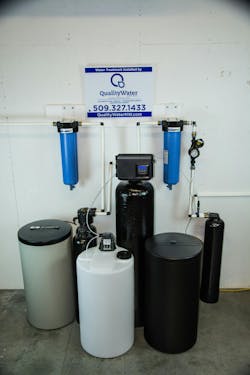About the author: Kate Cline is managing editor of WQP. Cline can be reached at [email protected].
The Spokane Indian Reservation in western Washington state is home to the Spokane, a tribe made up of more than 2,700 members and known as the “Children of the Sun.” The reservation’s 108,000 acres of forest, more than 10,000 lakes and 25 campgrounds offer recreation and scenery aboveground, but belowground, danger lurks.
That danger comes from naturally occurring deposits of uranium. Although it provided economic opportunity in the 20th century—several uranium mines were once active in the area—this contaminant is now causing trouble for the town of Wellpinit, a community of approximately 1,000 people located on the reservation.
A Radioactive Issue
Uranium was first discovered in the town’s groundwater during the sale of a home—which, like most in the area, relies on a private well for water—from the Spokane Indian Housing Authority to an individual tribal member, according to Brian Breuer, environmental engineer for the Indian Health Service’s Div. of Sanitation Facilities Construction. “They had the well tested as part of the sale,” Breuer said. “That was the first indication that there was an issue.”
After the initial discovery, Indian Health Service oversaw the testing of other water wells in the area. In all, 22 homes were found to have levels of either uranium or gross alpha particles (a measure of radionuclides in drinking water) that surpassed the U.S. Environmental Protection Agency’s (EPA) Maximum Contaminant Levels of 30 µg/L and 15 picocuries per liter, respectively.
According to EPA, exposure to uranium and gross alpha particles in drinking water could lead to increased risk of cancer. Uranium exposure also could result in toxic effects to the kidneys. Although there have not yet been any documented health issues related to these two contaminants on the reservation, according to Breuer, it was clear that removing them from drinking water was imperative.
Finding a Solution
Indian Health Service brought in Bret Ovnicek of Quality Water Northwest, a Kinetico dealership in Spokane Valley, Wash., to design and install water treatment systems for the 22 affected homes.
Residents were given a choice of point-of-use (POU) or point-of-entry systems. Although POU would have been a cheaper option, Ovnicek said, most residents opted for whole-house systems instead. “There are a lot of grandkids, and everybody is worried about them drinking out of other faucets,” he said, adding that some people also were not convinced that they could not absorb uranium through their skin. “They just wanted the extra peace of mind that the whole house was treated, instead of just the point of use.”
The first challenge in designing the whole-house systems was finding a resin that could treat for uranium—especially because there currently are no resins specifically certified for uranium removal by NSF Intl. Ovnicek turned to ResinTech Inc. to help find the right resin for the job. ResinTech recommended SBG2, a chloride form type 2 gel strong base anion resin intended for removal of contaminants, including uranium.
Using the SBG2 resin, Quality Water Northwest set up a pilot test using water from one of the homes with the highest levels of uranium. The initial test was successful, so the company set to work designing the system.
Basing the design on a nitrate removal system, the uranium treatment systems use 2.5 cu ft of resin, with a flow rate of 8 to 9 gal per minute. The media will be regenerated monthly, even though, Ovnicek noted, a mockup run by ResinTech using the worst-case scenario indicated that regeneration every three months would suffice.
The whole-house systems also required components to remove any constituents that could affect uranium treatment—in this case, primarily iron and hardness. Most of the homes had relatively low levels of ferrous iron, so sediment filters were sufficient. One home, where the water test revealed 20 ppm ferric iron, required a mechanical filter. Softeners also were added to protect the uranium systems from hardness and ferrous iron. The final component corrects the pH of the water. According to Ovnicek, the pH levels of the tested wells were relatively low, with some as low as 6.4. Not wanting to risk making the treated water corrosive by removing anions, a pH system was added to raise the level to around 7.5.
So far, the treatment systems have been installed in 11 homes, where they are successfully reducing uranium and gross alpha particles to non-detect levels. Plans are in place to install systems in the remaining 11 affected homes.
Download: Here
